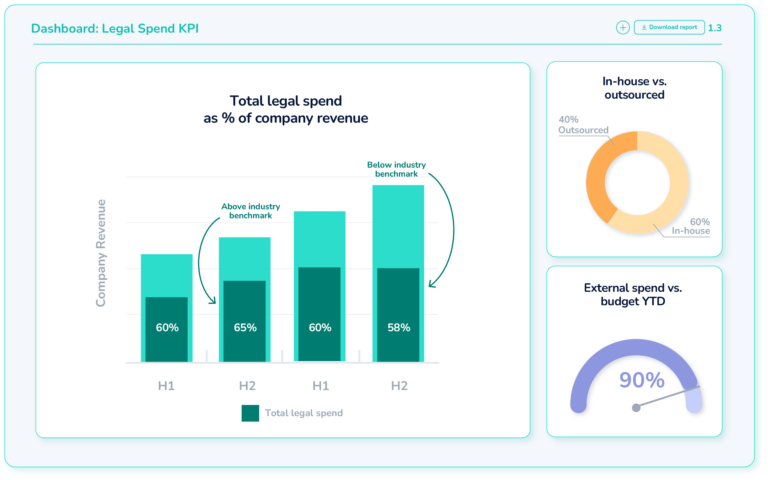The role of in-house legal leadership
The role of today's General Counsel (GC) or legal leader extends beyond traditional legal oversight. Managing an in-house team as an efficient and scalable business function requires a dynamic, forward-thinking approach - but it also means being a strategic business partner who is actively engaged in representing the impact and value of the legal function at executive leadership level.
However, your ability to effectively demonstrate the impact and value of your legal function to the wider business is far greater when it is backed up by data and metrics - and one of the most powerful ways to achieve this is through the use of Key Performance Indicators (KPIs).
Why KPIs?
KPIs are a foundational tool for capturing and measuring value, and for speaking the language of the business. As markers of progress and achievement, they offer a strong starting point for evaluating the performance and impact of the legal function within the context of a business' wider objectives.
As a legal leader, effective use of KPIs can considerably elevate the impact and value of your legal function. However, it's essential to establish the right KPIs for the job - and to choose the way that you measure, track, and present them across the business wisely. This guide is designed to help you do just that.
Tip
Metrics are an operational tool of measurement which relate to the outcomes of specific processes, tasks, or deliverables. KPIs are a strategic tool which rely on these metrics to assess and evaluate wider performance.
An objective-driven approach to KPIs
How effective are your KPIs if they aren’t aligned to a set goal? An objective-driven approach to KPIs ensures that every metric you measure is there for a reason, allowing you to align your data with clear and measurable objectives across both the legal function and the wider business.
For example, an objective-driven KPI is one which assesses how well your legal team is supporting specific business goals, such as revenue targets, scalability, or profitability. You may choose to prioritize contract efficiencies to directly impact commercial-oriented revenue goals or prioritize KPIs which optimize legal department costs to support the business's scale and profit goals.
KPIs and metrics can also serve as the basis for efficiency goals, becoming the foundations on which to set baselines, identify bottlenecks, and create opportunities to optimize existing legal workflows and processes.
By establishing objective-driven KPIs, as a legal leader you can:
- Recognize and anticipate your internal clients’ needs, delivering optimal outcomes
- Improve the way in which your legal function is operating and build evidence for conversations with stakeholders
- Understand, manage, and mitigate legal and operational risks
- Measure and enhance the real value of the legal function
By ensuring that your KPIs align closely with business objectives and are actionable in driving performance, you can effectively meet the complex demands of leading an in-house legal function.
Tip
Before setting KPIs, understand the objectives of your business and document them. Engage with key stakeholders such as functional partners, the CFO, and the board to ensure alignment and maximize the impact of your KPIs.
How to use this resource as a legal leader
This guide is intended to help you identify and use objective-driven KPIs to position your in-house legal function as a strategic partner within your wider organization. To implement this guidance effectively, you will need to:
- Identify the high-level strategic objectives of your wider organization that your legal function needs to support; and
- Identify specific objectives within your legal function which align with these high-level organizational goals (these will form the basis of your KPIs).
Getting a clear picture of the connection between your broader business objectives and their corresponding legal KPIs will allow you to demonstrate exactly how the latter contribute to propelling the business forward.
To get you started with this process, this guide introduces the five most critical KPIs, along with tailored suggestions for specific metrics and use cases that you can choose or adapt to your specific business environment. It also offers actionable insights on how you can apply these metrics operationally as the leader of your legal function.
So, what are the KPIs and metrics that your legal team should be utilizing, and why? Let's dive right in.
No. 1 Volume of work
Examples of volume-based KPIs
- Increase or decrease in the number of matters handled by the legal team over a specific period of time
- Total volume of work (matters and contracts) handled by legal versus the relative growth of the legal team and/or business, or versus the cost of the legal team
- Volume of contracts the legal team has been involved with and their value over a period of time
- The amount of high-risk, high-value matters the legal team is spending their time on, relative to those which are low-risk and low-value
- Increase or decrease in legal work related to specific departments, or in types of work which relate to business objectives, such as IP, strategic projects, sales growth, or partner agreements
To support this KPI, consider the following foundational metrics:




Why this KPI matters:
Volume, in combination with other data points such as value, risk, and business unit or type, paints a clear picture for executive leadership of where your legal team is spending time, and how that time relates to strategic business goals.
You can combine volume-related data points to illustrate positive trends or outcomes of strategic investment. For example, volume-based KPIs which show that your team is handling more high-risk, high-value matters year-on-year without increasing headcount indicates that legal is delivering scalable business value.
Reporting on volume of work by business unit or type - such as sales contracts or legal projects for a business unit supporting a strategic imperative - will help you craft a narrative around the way that your work is supporting specific teams and business priorities.
At the same time, prioritizing this KPI will arm you with the metrics to showcase the fact that your team is focusing its time in the right areas. This is an invaluable way to report on impact in order to influence decision making, both within your legal function and across the wider business.
Tip
Key considerations:
- Consider trends that are meaningful within your particular legal function and business. For example, is a higher volume of matters a positive or negative trend? Are there seasonal or quarterly trends, or times where you expect to see a surge or downturn?
- Look at trends and comparisons over time, including qualitative data points such as complexity, value, and risk
- Leverage data points such as the types of work you are carrying out or the business units your team is completing work for - allowing you to connect the dots to strategic business imperatives
- Benchmark against similar legal teams or industries
- Work backwards from goals you have set and programs you have initiated with the intention to drive scale, reduce cost or increase effectiveness
Reporting solely on the volume of work being processed by your legal team may show off how busy you are - but without reference to how it supports strategic outcomes, this information is of little use. Cross-referencing with other data points is critical if you want to meaningfully communicate the value of legal to executive leadership.
Tip
Successful legal leaders use LawVu to make data-driven decisions.
No. 2 Cycle times
Examples of time-based KPIs
- Overall percentage decrease in time to completion across all legal work, including matters and contracts, year-on-year
- Percentage increase in speed/reduction of turnaround time of high-volume, low-risk contracts versus more complex contracts
- Increase or decrease in matter turnaround times for complex matters and projects when compared to less complex work
- Comparative cycle times for specific types of work, or work completed in-house versus via outside counsel
- Time taken to assign legal work and provide a first response relative to the number of requests received, compared across timeframes
- Invoicing turnaround times and related payment discounts
To support this KPI, consider the following foundational metrics:




Cycle time KPIs communicate how your team is improving efficiency and legal service delivery. Including contextual data points creates a connection with strategic initiatives and business goals.
Why this KPI matters:
Far more than simply capturing start and end dates, this KPI represents the detail of how quickly work is executed. With the right context, this lets you demonstrate to executive leadership not only the fact that your legal team is accelerating business outcomes, but exactly how it is doing so - from creating commercial value and improving service delivery to reducing risk and controlling costs.
Cycle times are also a great way to measure the outcomes of strategic initiatives and your team's ability to deliver services at scale. For example, if you invest in contract automation technology, your KPIs may help you to demonstrate an improvement in cycle times for high-volume, low-risk contracts without having to increase headcount. If you invest in specialized training or staffing initiatives, KPIs which show a decrease in risk or faster resolution of issues are a great way to showcase their success.
Tip
Key considerations:
- Speed alone is not an effective measure of good performance and can be dangerous if used without context or consideration of risk profile. Often, start and end dates alone will not contain the most critical insights
- With this in mind, do not simply focus on cycle times - consider how they tie in with the wider work that your legal team does to support the business. Combine data points to add context, such as contract and matter types, complexity, value, work carried out for certain departments, or outcomes
- Tie your KPIs to Service Level Agreements, deadlines, or other hard measures of success, or use your KPIs to inform their development
Communicate wisely about these KPIs! For best practice, make sure that you are always measuring trends, and that you are presenting your foundational metrics in context. For example, a complex contract may take longer to complete, but have more impact on the business’ success. Being able to communicate these nuances to leadership will take the focus away from time-based measures of success and highlight the value legal is bringing to the organization.
No. 3 Legal spend
Examples of legal spend KPIs:
- Total legal spend and costs as a percentage of company revenue
- Trends (increase or decrease) in total legal spend relative to company size, by reference to revenue or employee count
- Ratio of inside versus outside legal spend
- Budget to actual total spend comparison (year-to-date compared with previous years)
- Total legal spend and trends by business unit or work type
To support this KPI, consider the following foundational metrics:




Legal spend KPIs demonstrate resource allocation and impact, performance against budget, benchmarks and ability to scale legal services over time in a cost-effective way.
Why this KPI matters:
Legal spend KPIs are a pivotal part of reporting for several reasons. As a legal leader, you are expected to be able to provide clear information about the cost of running your department, including expenditure against benchmarks and budgets.
However, turning your spend-related data into KPIs using thoughtful narratives is a powerful way to demonstrate the value that your team is delivering to the business. That’s because you can tie costs directly to the things your C-suite and board care about: outcomes delivered by your legal team, the overall cost of legal work, the financial impact of legal issues on the company, and the ways in which you are managing your function to scale and align with strategic priorities.
The key to using spend-based KPIs successfully is context: use qualitative and comparative data points to connect the dots between cost and outcomes for your audience. For example, legal spend on its own is just a number (albeit an important one), but a benchmark KPI such as legal spend as a percentage of company revenue over time showcases the ways in which your team is scaling, and that strategic initiatives are paying off.
Tip
Key considerations:
- Time-based comparisons and trends are critical when applying spend related KPIs as they allow you to exhibit both context and progress
- Consider KPIs that align with cost-saving initiatives you have in place, such as reducing outside counsel rates, staffing strategies, or technology initiatives
- Using benchmark data can help you assess and communicate value by showing how your department compares to others. But remember that benchmarking comes with caveats - those that you are measuring against may come from a different industry, risk profile, and business stage than your own, and this should always be taken into account
- Breaking down cost information by work types, complexity, risk, value, business unit, and outcomes will provide important context
- Remember that legal spend is not just outside counsel work, it’s all your internal work and costs too - so finding a reasonably easy way to collate this data is critical
By utilizing meaningful spend-based KPIs which measure trends across all of your outsourced and internal work, you will not only elevate the cost-effectiveness of your legal function and improve your bottom line - you will also position your team in front of the wider business as a value creator, not a cost center.
No. 4 Internal client satisfaction
Today’s legal leaders strive to be a valued business partner to busy stakeholders who, because they operate in a dynamic environment, have high expectations of service. In order to maintain a customer-oriented, team-based mindset, your KPIs must contain data that reflects your clients’’ experience in meaningful ways.
Examples of internal client satisfaction KPIs:
- NPS or CSI ratings by comparative time frame, such as year-on-year
- Changes in cycle or response times for specific types of legal work which matter significantly to internal clients, or relate to strategic initiatives
- Measures of engagement and influence, such as trends around rates of legal requests relative to company size, or compliance with legal policies and guidelines
- Trends in use of innovative legal resources introduced to solve business problems, such as intake process adoption rates and usage rates of self- service templates and guides over time
To support this KPI, consider the following foundational metrics:




KPIs for customer satisfaction communicate how your business partners experience and value your contributions and demonstrate the impact of strategic initiatives such as improving legal service.
Why this KPI matters:
The way that your legal team is perceived across your wider business is a key measure of its success. While anecdotal evidence of internal satisfaction might be easy to come by, hard numbers are crucial if you want to set benchmarks, show progress, and demonstrate your role as a strategic partner.
NPS and CSI ratings are a critical tool in using data to represent the quality of your team’s work and perception in the business. When using these metrics, assessing trends is key - for example, you might aim for consistent or rising rates of satisfaction over time.
Using quantitative measures of engagement as key indicators of customer experience can be trickier, but highly powerful. Start by considering the key objectives of your legal team in relation to wider business strategies, and then consider what stakeholder behavior might signal how well you are achieving them.
For example, if a key objective is to scale legal services without increasing risk, you might consider utilizing KPIs which indicate ability to self-serve legal help, such as increased use of legal FAQ, templates, or contract automation tools. Or, if you are concerned about a perception of legal as a “black box” acting as a detractor from service requests, measuring increasing or decreasing volumes of requests over time would be a good KPI to set.
Cycle and turnaround times can also be useful indicators of satisfaction levels, particularly when tied to known strategic objectives which can be measured by specific types of work. For example, if turnaround times are getting in the way of capturing commercial value, a meaningful KPI would monitor your success in reducing them through automation of low-risk routine contracts or responsible use of AI. Similarly, if you are introducing new tech or processes to streamline your intake process, you might create a KPI which tracks the number of requests received relative to time to assignment, or response times for meeting SLAs.
Think outside the box, and always put yourself in your internal clients’ shoes. Understanding what influences their perception of your legal function is critical to developing high-impact KPIs. And, of course, consider your own team’s levels of satisfaction, too!
Key considerations:
- Combine quantitative metrics with qualitative insights to get a holistic view of customer satisfaction
- Start simple when gathering NPS or CSI scores to maximize your chances of getting feedback from busy stakeholders
- If you can, include interviews or open-ended survey questions to get deeper insights into the experiences and preferences of others in the business
- Time-based assessment and stories, like trends or comparisons year on year, will be critical to measure changes in perception and the impact of your efforts
- Balancing competing business priorities like risk mitigation, compliance, and budget restrictions while also delivering a satisfactory experience for other departments will require careful consideration and judgment
No. 5 Innovation
Legal technology and process innovation are crucial enablers for modern legal functions. These tools improve the way in which your team completes and manages their day-to-day work, but they are also opportunities to build your brand.
If your investments are well aligned with your business goals, KPIs which prove their value and impact will naturally showcase your delivery against those goals - all the while improving perceptions of your legal function and the way it is led.
Examples of innovation-based KPIs:
- Percentage of legal department actively using legal technology, and rates of business user adoption over time where appropriate
- Indicators over time of increased efficiency, productivity, and scale such as time saved, reduction in turnaround times, faster invoice processing times, uptake of automated workflows
- Dollar amount of, or percentage reduction in costs associated with legal operations or outside counsel fees attributed to the use of legal tech
- Ratio of the financial benefits (e.g. cost savings, revenue enhancement) gained from the implementation of legal technology tools to the total investment made in acquiring and implementing those tools
To support this KPI, consider the following foundational metrics:




Legal Innovation KPIs demonstrate the adoption and impact of investments in technology and process improvement
Why this KPI matters:
While legal technology and process innovation are enablers for modern legal functions, both require buy-in and investment from the wider business. So, it’s critical to create KPIs which relate directly to the levels of uptake and impact that these investments are having on peers across your organization.
The stories generated by innovation-based data are also a valuable way to elevate your team’s brand and leadership profile. They can help reshape perceptions of legal from laggard to cutting-edge and create the digital foundations you need to forge a data-driven relationship with the wider business.
Measuring adoption and impact levels of your legal technology is an obvious place to start. Because your investments should have been driven by desired outcomes, the most suitable KPIs here should be self-evident - but you can strengthen them further by extending their scope beyond efficiency to include impact on key performance indicators and strategic goals.
For example, if you have invested in contract management software, consider KPIs such as decreases in cycle time combined with adoption levels by both legal and other departments over time. If you have invested in e-billing solutions, your KPIs should reflect not just efficiency but the impact on total legal spend relative to your business goals. The success of an investment into an intake solution should be measured by reference to trends in usage alongside qualitative measures of satisfaction, turnaround times, and speed of reporting.
Tip
One of the biggest benefits of investing in legal technology is that it empowers legal leaders to create and share objective-driven data stories. When measured over time, this data can help you find ways to extract even more value from your tech.
Key considerations:
- When communicating your KPIs, be clear about how legal technology aligns with broader organizational goals and objectives (for example, how it contributes to cost savings, risk mitigation, and operational efficiency)
- As is the case with most KPIs, it’s important to factor in a time or trend-based assessment, as legal technology adoption has a life cycle
- Innovation-based data stories will naturally always have a “before and after” component. Be sure to include relevant information about types of work and comparative time frames to add the necessary context
- Assess the flexibility of any technology solution that you use to adapt to changing requirements, workflows, and user preferences. Do they make effective reporting easier?
When it comes to technology, use KPIs that address all facets of your work in which tech is involved, including matter, contract, and spend management - and especially intake and self-service.
Final tips and considerations
Now that you’re equipped with the five KPIs and metrics every legal leader needs to know, here are some final tips and considerations:
- Apply an objective-driven approach to ensure that your KPIs align closely with business objectives and are actionable in driving performance
- The KPIs and metrics you choose will almost always contain insights that can be used to improve your team's function, so consider what you can do with that data at an operational level
- Where possible, set up dashboards which let you easily access and visualize the data and metrics that support your chosen KPIs. This should also make it easier to present them clearly to the wider business
- If you don’t have all the dashboards and baselines set up right away, don’t let this stop you from getting started. Consider how gathering feedback from peers and developing a tech roadmap can help you build up a business case.
- Implement a regular reporting cadence to ensure that you get the most from your data and are able to turn real-time insights into action items
- Most importantly, ensure that your reporting accounts for all the work your legal team does - both internally and externally. Some consolidated tech solutions will make this easier
Representing the value of your in-house legal function at executive leadership level is an integral part of being an effective legal leader - and tracking the right KPIs is a critical way to build the quantifiable evidence you need to demonstrate your impact.
By identifying and implementing objective-driven KPIs which are tied to the goals of both your legal team and the wider business, you will position your legal function where it deserves to be - at the strategic center of your business operations.
The role of technology
For any legal leader to effectively align their KPI’s to business objectives, there are 3 technology imperatives:
A single source of truth
The more your legal data is distributed across multiple systems, the harder it becomes to capture and analyze the foundational metrics you need for good KPIs. It’s not uncommon for legal teams to spend days generating reports because data needs to be pulled from multiple systems. Consolidated platforms such as LawVu, which encompass all of your legal work, allow you to analyze and report on your matter, contract and spend data from one place.
Built for efficiency and scale
A consolidated platform means managing all of your data in one place, enabling efficiency gains as a result of centralized reporting. Better yet, if the consolidated platform is scalable, functionalities can be introduced gradually - reducing the risk of overinvestment in capabilities beyond the needs of your legal function. By starting simple and solving your biggest problems first, you’ll be able to prove ROI to your CFO at renewal time, and set the foundations to add further capabilities later on.
Easy to use, and therefore easy to adopt
Invest in technology which is simple to use and specifically designed for in-house legal workflows. A simple UI with familiar workflows will increase adoption, which is essential if you are to gather sufficient data to establish a full picture of your legal work, including KPIs and the value you deliver.
